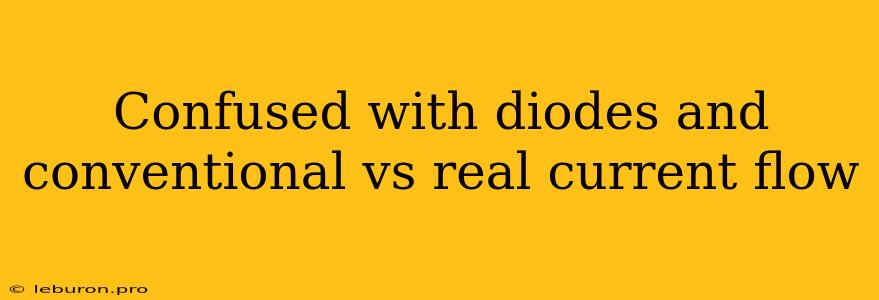The world of electronics can be a fascinating yet confusing journey. While the fundamentals are straightforward, some concepts, such as diodes and the perplexing flow of current, often leave beginners bewildered. This article aims to shed light on these seemingly contradictory aspects, helping you understand diodes and the difference between conventional and real current flow. By unraveling these mysteries, you'll gain a deeper understanding of how electricity works and confidently navigate the intricacies of electronic circuits.
Understanding Diodes: The One-Way Street of Electricity
A diode is a semiconductor device that allows current to flow in only one direction. It acts like a gatekeeper, permitting the flow of electricity in the forward direction but blocking it in the reverse direction. This unique property makes diodes essential components in various electronic applications, from rectifying alternating current (AC) to protecting sensitive circuits.
How a Diode Works
A diode consists of two semiconductor materials, typically silicon, joined together. One side is doped with impurities to create an excess of electrons (n-type), while the other side has a deficiency of electrons, creating an excess of holes (p-type). This junction creates a depletion region, an area devoid of free charge carriers.
When a positive voltage is applied to the p-type material (anode) and a negative voltage to the n-type material (cathode), the electric field across the depletion region decreases, allowing electrons to flow from the n-type to the p-type material. This is the forward-biased condition, and current flows easily through the diode.
Conversely, when a negative voltage is applied to the p-type material and a positive voltage to the n-type material, the electric field across the depletion region increases, preventing electrons from flowing. This is the reverse-biased condition, and the diode effectively blocks current flow.
Conventional Current Flow vs. Real Current Flow: A Clash of Concepts
Understanding conventional and real current flow is crucial to grasp how electricity moves within a circuit.
Conventional Current Flow
Conventional current flow is a historical concept that assumes current flows from the positive terminal of a battery to the negative terminal. This convention was established before the discovery of electrons and their role in electricity.
Real Current Flow
Real current flow, on the other hand, describes the actual movement of electrons. Electrons, carrying a negative charge, flow from the negative terminal of a battery to the positive terminal.
The confusion arises because conventional current flow is still widely used in circuit diagrams and analysis. It's important to remember that conventional current flow is a convenient abstraction, while real current flow represents the actual physical movement of charge carriers.
Reconciling the Two: A Unified View
While conventional current flow and real current flow seem contradictory, they are essentially different perspectives on the same phenomenon. The key is to understand that both describe the same movement of charge carriers, just from opposing viewpoints.
Think of it like a car driving on a highway. If you were looking at the car from the front, you'd see it moving forward. If you were looking at the car from the back, you'd see it moving backward. Both perspectives are correct, even though they seem opposite.
Similarly, conventional current flow focuses on the direction of the electric field, while real current flow focuses on the movement of electrons. Both concepts describe the same flow of electrical energy, just from different perspectives.
Applications of Diodes: Where the One-Way Street Leads
Diodes are ubiquitous in modern electronics, performing diverse functions due to their unique ability to control the flow of current.
Rectification: Transforming AC to DC
Diodes are essential for converting alternating current (AC) to direct current (DC). By allowing current to flow in only one direction, diodes can be used to create a unidirectional current flow from an AC source, making it suitable for powering various electronic devices.
Protection: Shielding Circuits from Damage
Diodes can protect sensitive circuits from voltage spikes or reverse current flow. By blocking current in the reverse direction, diodes act as safeguards, preventing damage to delicate components.
Signal Processing: Shaping and Controlling Signals
Diodes are used in various signal processing applications, including clipping, clamping, and voltage limiting. Their ability to control the flow of current allows them to modify and shape electrical signals, enhancing their performance.
Conclusion: Embracing the One-Way Street
Understanding diodes and the concept of conventional vs. real current flow is crucial for navigating the complex world of electronics. By recognizing the different perspectives on current flow and appreciating the unique properties of diodes, you'll gain a deeper understanding of how electricity functions and how it's harnessed in various applications. Embrace the one-way street, and your journey through electronics will become smoother and more fulfilling.
